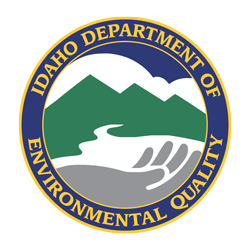| Data | Details |
|---|---|
| Hydrologic Unit Codes | 17040202 (Upper Henrys) 17040203 (Lower Henrys) |
| Size | 1,068 square miles (683,520 acres) |
| Water Bodies with EPA-Approved TMDLs (Category 4a) | Buffalo River, Conant Creek, Duck Creek, Howard Creek, Sheridan Creek, Targhee Creek, Timber Creek, Warm River |
| Beneficial Uses Affected | Cold water aquatic life, salmonid spawning |
| Major Land Uses | Agriculture, recreation, forestry, recreational development |
| Approved by EPA | Subbasin assessment only; not subject to EPA approval |
| Addendum Approved by EPA | August 2010 EPA Approval Letter |
| E. Coli TMDL Approval | March 2021 EPA Approval Letter |
Subbasin Characteristics
The Upper and Lower Henrys Fork subbasins are located in eastern Idaho near Yellowstone National Park. The Upper Henrys Fork subbasin is the origin of the Henrys Fork of the Snake River. Parts of the subbasin are also located in Wyoming and Yellowstone National Park. The quality of surface waters within the subbasin is generally good, with almost half of the water derived from springs in nearly pristine condition. The northern portion of the subbasin is geologically rich in phosphorus, and the highly enriched waters of Henrys Lake support a trophy trout fishery. The division between the upper and lower subbasins is the Ashton Reservoir.
The majority of the land in these two subbasins is managed by the US Forest Service. The economy of the region has historically been based on livestock grazing, timber production, and cultivated agriculture. Irrigated agricultural lands outside the subbasins are supplied with water stored in two reservoirs: Henrys Lake and Island Park. The Henrys Fork fishery has an international reputation among fly fishers, and anglers drawn to the area are increasingly important to the local economy.
1998 Subbasin Assessment
The information presented in the subbasin assessment indicates TMDLs are not necessary. Seasonal depletion of dissolved oxygen in Henrys Lake is a function of naturally high concentrations of phosphorus in the lake’s watershed. Sediment loading was due to a distinct event associated with drawdown of Island Park Reservoir in 1992. Both Henrys Lake and Henrys Fork support the beneficial uses of cold water biota and salmonid spawning. Therefore, TMDLs were not developed and the water bodies were recommended for removal from the §303(d) list.
2010 Addendum
This document addresses 14 water bodies and their associated assessment units in the Upper and Lower Henry’s Fork subbasins that were placed on Idaho’s 2008 Integrated Report. No streams were originally listed on the Idaho 1998 §303(d) list for temperature pollution in these subbasins. However, the US Environmental Protection Agency (EPA) added streams to Idaho’s 1998 §303(d) list of impaired waters that potentially exceeded Idaho’s temperature criteria. Among those EPA additions, Duck Creek, Howard Creek, Targhee Creek, Timber Creek, and Warm River were listed for temperature in the Upper Henry’s Fork subbasin. Other streams were listed as impaired due to low bioassessment scores as determined by DEQ. Streams in the Upper and Lower Henry’s Fork subbasins were listed as impaired in the 2008 Integrated Report due to flow alteration, sediment, bacteria, and temperature.
2010 Addendum: Streams and Pollutants for Which TMDLs Were Developed
| Stream | Pollutants |
|---|---|
| Warm River | Temperature |
| Buffalo River | Temperature |
| Howard Creek | Temperature |
| Targhee Creek | Temperature |
| Timber Creek | Temperature |
| Duck Creek | Temperature |
| Sheridan Creek | Temperature |
| Conant Creek (Squirrel Creek) | Temperature |
2021 Escherichia coli and Sediment TMDLs
| Stream | Pollutants |
|---|---|
| Twin Creek | Sediment |
| Timber Creek | Escherichia coli |
| Sand Creek | Sediment |
Subbasin Document(s)
- Upper Henrys Fork Subbasin Assessment (December 1998)
- Upper and Lower Henrys Fork Total Maximum Daily Loads: Addendum to the Upper Henrys Fork Subbasin Assessment and TMDLs (June 2010)
- Upper and Lower Henrys Fork TMDL Five-Year Review (April 2010)
- Upper and Lower Henrys Fork: TMDL Five-Year Review (March 2017)
- Upper and Lower Henrys Fork: 2021 Sediment and Bacteria TMDLs (January 2021)
- Upper and Lower Henrys Fork Implementation Plan for Agriculture (October 2022)


